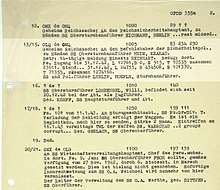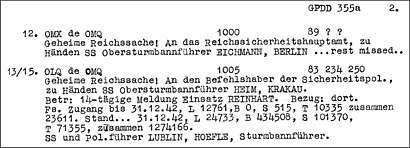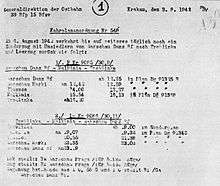Höfle Telegram
The Höfle Telegram (or Hoefle Telegram) is a cryptic one-page document, discovered in 2000 among the declassified World War II archives of the Public Record Office in Kew, England. The document consists of several radio telegrams in translation,[1] among them a top-secret message sent by SS Sturmbannführer Hermann Höfle on 11 January 1943; one, to SS Obersturmbannführer Adolf Eichmann in Berlin, and one to SS Obersturmbannführer Franz Heim in German-occupied Kraków (Cracow).[2][3]

The Telegram contains the detailed statistics on the 1942 killings of Jews in the extermination camps of Operation Reinhard including at Belzec (B), Sobibor (S), Treblinka (T), and at Lublin-Majdanek (L). The numbers were compiled and quoted by Höfle, likely from the very precise records shared with the Deutsche Reichsbahn (DRG).[3] Even though the Holocaust railway transportation records were notoriously incomplete as revealed by the Main Commission for the Investigation of German Crimes against the Polish Nation,[lower-alpha 1] the quoted numbers shed a new light on the evidential standard of proof for the scope of the crimes committed by the SS. The telegram gave train arrivals in the prior fortnight, as well as cumulative arrivals until 31 December 1942, for the extermination camps during the deadliest phase of the "Final Solution".[5]
Background
All Holocaust trains were run by the Deutsche Reichsbahn. The SS paid German Railways the equivalent of a third class ticket for every prisoner transported via the Holocaust trains (Sonderzüge) to the extermination camps of Operation Reinhard from Ghettos in Nazi-occupied Europe and Jewish ghettos in German-occupied Poland.[6] Children under four went free. The payment was collected from the SS by the German Transport Authority on behalf of the Reichsbahn according to a schedule, at a cost of 4 Pfennig per track kilometer.[7] The actual waybills did not include the number of prisoners in each cattle car because calculations were predetermined.[8] The standard means of delivery was a 10 metre long covered goods wagon, although third class passenger carriages were also used with train tickets paid by the Jews themselves, when the SS wanted to keep up the "resettlement to work in the East" myth.[9] The DRB railway manual, which was used by the SS for making payments, had a listed carrying capacity of each trainset setup at 50 boxcars, each loaded with 50 prisoners.[10]
In reality, boxcars were crammed with up to 100 persons and routinely loaded from the minimum of 150% to 200% capacity for the same price.[10] Notably, during the mass deportation of Jews from the Warsaw Ghetto to Treblinka in 1942, trains carried up to 7,000 victims each, which reduced the cost to the SS by more than half.[11] According to an expert report established on behalf of the German "Train of Commemoration" project, the receipts taken in by the state-owned Deutsche Reichsbahn for mass deportations in the period between 1938 and 1945 reached a sum of US $664,525,820.34.[12]
Translation
The Höfle Telegram is a decoded message, encrypted at source by the German Enigma machine.[13] A missing "5" is added in the table, and is considered to be the correct figure, because only the number 713,555 yields the correct total of 1,274,166, and also the Korherr Report of 1943 substantiates that the total number of 1,274,166 Jews subjected to "special treatment" (Sonderbehandlung) in the General Government district of German-occupied Poland is correct to the last incongruous digit.[3] The British decoded version of the Telegram would almost certainly be a transcription error, since British security clearly did not realise what this message was about (see above). It is unlikely that the numerical mistake would have been noticed by them at the time. Admittedly the interception and decoding was not 100% accurate (see reproduction).
| Original in the German language | Complete English translation |
|---|---|
 The Hofle Telegram (including two small PRO annotations) |
12. OMX de OMQ 1000 89 ? ?
State secret! To the Reich Security Main Office, for the attention of SS Obersturmbannführer EICHMANN, BERLIN [...rest missed...] 13/15. OLQ de OMQ 1005 83 234 250 State secret! To the commander of the Security Police, for the attention of SS Obersturmbannführer HEIM, KRAKAU. Re: 14-day report Operation REINHARD. Reference: radiogram from there. Recorded arrivals until 31 December 42, L 12761, B 0, S 515, T 10335 totaling 23611. Situation [ ... ] 31 December 42, L 24733, B 434508, S 101370, T 71355, totaling 1274166. SS and police leader of Lublin, HOEFLE, Sturmbannführer. |
Importance of the document
prior to 31 December 1942 |
31 December 1942 | |
| L (Lublin, i.e. Majdanek) | ||
| B (Bełżec) | ||
| S (Sobibor) | ||
| T (Treblinka) | ||
| Total |
According to the US National Security Agency and the Holocaust historians, "it appears the British analysts who had decrypted the message missed the significance of this particular message at the time. No doubt this happened because the message itself contained only the identifying letters for the extermination camps followed by the numerical totals. The only clue would have been the reference to Operation Reinhard, the meaning of which – the plan to eliminate Polish Jewry that was named after the assassinated SS General Reinhard Heydrich – also probably was unknown at the time to the codebreakers at Bletchley."[13]
The Höfle's radio telegram is one of two evidential proofs making use of the very precise figures, suggesting their common origin; the other one is the Korherr Report to Himmler by professional statistician Dr Richard Korherr from January 1943. Both of them quote exactly the same number of Jews "processed" during Operation Reinhard. Apart from providing identical totals as of December 31, 1942, the Höfle Telegram also indicates that the camp at Lublin (Majdanek) was part of Odilo Globocnik's Operation Reinhard, a fact that historians previously had not fully realised.[5]
See also
- Jäger Report, 1941
- Einsatzgruppen reports, 1941–1942
- Wilhelm Cornides Report, 1942
- Katzmann Report, 1943
- Korherr Report, 1943
- Gerstein Report, 1945
- Riegner Telegram, 1942
- Special Prosecution Book-Poland, 1937–1939
Notes
- The Armia Krajowa communiqués detailing the number of trains arriving at Operation Reinhard death camps augmented by the demographic information regarding the number of people deported from each ghetto, were published by the Polish Underground State through the Biuletyn Informacyjny newspaper (BI) on behalf of the exiled Polish government in London.[4]
Citations
- "The Hoefle Telegram". National Archives. Kew, Richmond, Surrey. 2017. Catalogue reference HW 16/23.
- Public Record Office, Kew, England, HW 16/23, decode GPDD 355a distributed on 15 January 1943, radio telegrams nos 12 and 13/15, transmitted on 11 January 1943.
- Witte, Peter; Tyas, Stephen (Winter 2001). "A New Document on the Deportation and Murder of Jews during "Einsatz Reinhardt" 1942". Holocaust and Genocide Studies. Oxford University Press. 15 (3): 472. doi:10.1093/hgs/15.3.468. Retrieved 5 May 2015.
- Grzegorz Mazur (2013). "The ZWZ-AK Bureau of Information and Propaganda". Essays and Articles. Polish Home Army Ex-Servicemen Association, London Branch. Retrieved 1 December 2013.
- Abstract: Peter Witte and Stephen Tyas, “A New Document on the Deportation and Murder of Jews during ‘Einsatz Reinhardt’ 1942.” Holocaust and Genocide Studies 15:3 (2001) pp. 468-486.
- Types of Ghettos. United States Holocaust Memorial Museum, Washington, D.C.
- Richard L. Rubenstein, John K. Roth (2003). Approaches to Auschwitz. Westminster John Knox Press. p. 362. ISBN 0664223532.
- Holocaust Education & Archive Research Team (2007). "Documents Related to the Treblinka Death Camp". Holocaust Research Project.org. Archived from the original on 17 October 2014. Retrieved 10 August 2014.
Bundesarchiv - Fahrplanordnung 567.
- Hedi Enghelberg (2013). The trains of the Holocaust. Kindle Edition. p. 63. ISBN 978-160585-123-5.
Book excerpts from Enghelberg.com.
- Geoffrey P. Megargee (2009). The United States Holocaust Memorial Museum Encyclopedia of Camps and Ghettos, 1933-1945. Indiana University Press. p. 1514. ISBN 0253003504. Retrieved 4 February 2014.
- "Treblinka: Railway Transports". This Month in Holocaust History. Yad Vashem. Archived from the original on 8 October 2014. Retrieved 4 February 2014 – via Internet Archive.
The Treblinka extermination process was based on experience the Germans had gained in the Belzec and Sobibor camps. An incoming train, generally consisting of fifty to sixty cars (containing a total of 6-7,000 persons), first came to a stop in the Treblinka village railway station. Twenty of the cars were brought into the camp, while the rest waited behind in the station.
CS1 maint: BOT: original-url status unknown (link) - Train of Commemoration (November 2009). "Zusammenfassende Bilanz". Expert Report on the Deutsche Reichsbahn's Receipts (PDF). Obtained during the Nazi Dictatorship for Services in Transporting Persons from the German Reich and Occupied Areas of Europe to Concentration Camps (in German, English, French, and Polish). Train of Commemoration Registered, Non-Profit Association, Berlin. p. 53. Archived from the original on 22 February 2014. Retrieved 4 February 2014 – via direct download from Wayback.
With payment summaries, tables and literature.
CS1 maint: BOT: original-url status unknown (link) - Robert J. Hanyok (2005). Eavesdropping on Hell: Historical Guide to Western Communications Intelligence and the Holocaust, 1939-1945. Volume 10. Courier Corporation. pp. 89–90. ISBN 0486481271. Retrieved 6 May 2015.
